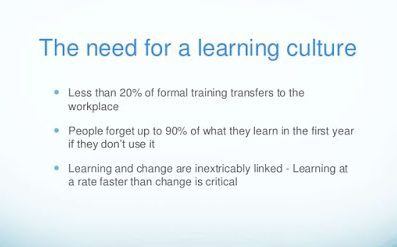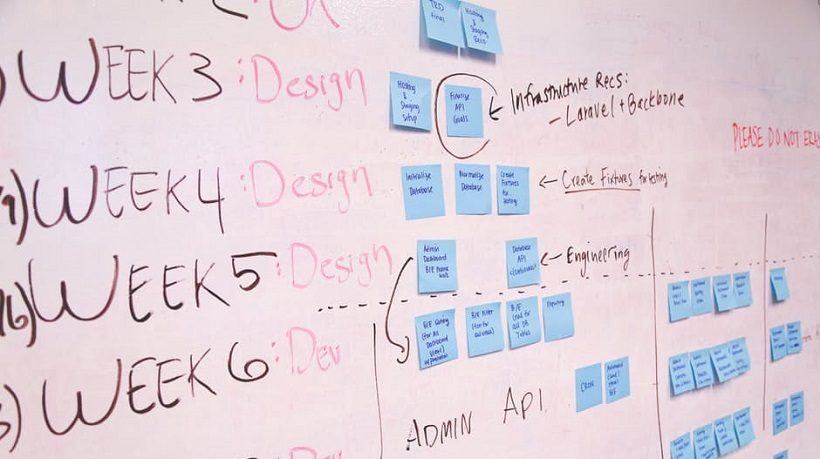How To Build An Effective Learning Culture: A Revolution In Business Perspectives
Your customers of past years have changed, and your new prospects are even more different in their needs and ways of looking at things that customers in the last decade.
"Don't panic, but you do need to take the first steps to being a proactive rather than a reactive organization where learning is part of the business mindset. Where employees pursue their learning because they see it as in the best interests of their organization and their own growth. This is part of what creates a sense of community or family within an organization".
In this age of exponential knowledge growth coupled with the advancement of technology, moving forward effectively to capitalize on the benefits of a globally connected, collaborative society of networks, requires leadership from the top that knows that company vision needs to be adaptive, dynamic and flexible. In other words, CEO's, CFO's, and CLO's need to stop devaluing the importance of the learning culture by only looking at spreadsheets in a two-dimensional manner. This is the same idea as not being able to see the forest for the trees. The learning culture of an organization needs to be a reflection of the connected community that employees live in outside the walls of the organization.

What Should Be the Characteristics Of A Learning Organization In The 21st Century?
Leadership
The number of articles and books that deal with leadership are almost as numerous as sand at a beach. I remember one particular book that I found fascinating was titled: "The Organization of the Future (1997)" which was a collection of writings by "thought leaders" of the time compiled by the Drucker Foundation. The section titles give you a good idea of the primary drivers of the book. Some were:
- Part I
Shaping tomorrow's organizations - Part IV
Working and organizing in a wired world - Part V
Leading people in the organization of the future
In the time they were writing, the internet was just coming into the mainstream and business leaders were being encouraged to develop a new vision that would include the utilization of this new frontier that was opening up. Some paid attention, some did not. When you combine the need to change the learning culture of business with what Peter Senge states in his even earlier book titled: "The Fifth Discipline: The Art and Practice of the Learning Organization(1990)", a common thread emerges.
"Business leaders need to be proactive, not reactive to the changes occurring outside the walls of their organization. They need to be aware of the transformations occurring in the global economy and based upon that, come up with a shared vision that recognizes that we are living in an age of information and learning".
Again, those who are led by the business leaders need to see a natural fit between the world that they live in daily and the workplace. If that perception is not there then the employees will experience a disconnect between what business expects of them and what their clients and customers expect of them.
Role Re-Definition
It is the vision that directs everything else in a business organization. It is the vision that encapsulates core values that an organization considers important. One of the effects of a change in vision is the need to re-examine the nature of the roles of those who are intimately connected to the learning culture of the organization. This is an element of what we would term "organizational design".
Instructional Designer
The ID needs to use design thinking to design irresistibly engaging learning experiences for learners that go beyond the typical "tell them what they need to know and pray that they follow through" approaches of the past. Reflecting on the advancing research on how people learn, the design of learning experiences should take into consideration the following elements and understandings:
- Learners become more engaged in their learning when they have the opportunity to collaborate with other learners on relevant, problem based real-world problems as seen within the context of the organization's interests. Unlike in the past when collaboration was largely restricted to the trainer as the "sage on the stage" and the learners in the training session within the local walls, through the effective use of blended eLearning collaboration, should be between learners within the organization networks where a learner is Spokane is teamed up with a learner in Washington, a learner in Rio de Janeiro, and a learner in Montreal, Canada. In a connected, collaborating learning culture within an organization, there are no walls. This can be designed into the learning experience.
- Kill the meaningless "point and click interactivity" that treat learners as simpletons! Too many eLearning experiences in the past have had learners proceed through a series of point and click exercises comparable to rats in a Skinnerian maze. Thoughtful engagement means taking the learners on a journey where they use their creativity, initiative, talents, and intelligence to collaborate and solve meaningful tasks and receive useful feedback on the decisions they are making. This is also the cradle in which innovation can be nurtured. This, too, can be designed into the learning experience. The trainer in this scenario is the " guide on the side and co-learner in the experience ". This is the type of learning that provides deep and sustainable understanding where the learner does not need to be externally motivated to apply new skill sets and understandings in their roles. Instead, what is created is an overwhelming intrinsic drive to follow through. Some good examples of design tools that make this possible are Articulate 360 with Story Line 3.0 and Branch Track.
- Accessibility to the learning culture for collaboration should be available from any digital device no matter where the learner is 24/7. With the development of HTML 5.0, there is really no excuse. This is the greatest potential of microlearning and mobile learning. Learning should be personalized to the needs of the learner. This is where Instructional Designers need to collaborate with HR departments and IT departments so that learners have stress-free access on their terms.
One question for you to consider:
"For many organizations in the past, the SME has been an essential person or group of persons relied upon for content for training. If our goal is to encourage learners within an organization to take control of their learning in the best interests of the organization and their own growth and to learn how to learn in a connected online environment, where does the SME fit in or does he or she fit in?".
Through effectively developed online collaborations that can create task focused problem solving and innovative system thinking, organizations can not only develop a highly effective learning culture but also lead the way to the top in making their brand world renown. Now is the time to roll up our sleeves and make it happen!









